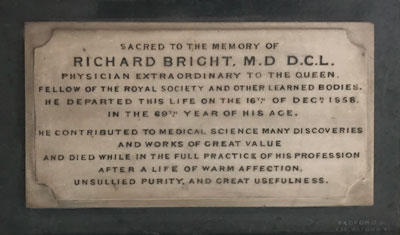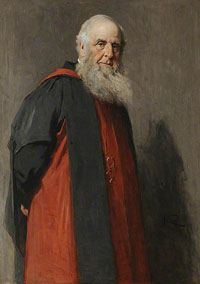Richard Bright, was a British physician who was the first to describe the clinical manifestations of the kidney disorder known as Bright's disease, or nephritis.
Bright excelled at making meticulous clinical observations and correlating them with careful postmortem examinations. The results of his wide-ranging researches first appeared in Reports of Medical Cases (1827), in which he established edema (swelling) and proteinuria (the presence of albumin in the urine) as the primary clinical symptoms of the serious kidney disorder that bears his name. Bright's subsequent papers on renal disease were published in a second volume of reports (1831) and in the first volume of Guy's Hospital Reports of 1836.
He was born in Bristol, Gloucestershire, the third son of Sarah and Richard Bright Sr., a wealthy merchant and banker. Bright Sr. shared his interest in science with his son, encouraging him to consider it as a career. In 1808, Bright Jr. joined the University of Edinburgh to study philosophy, economics and mathematics, but switched to medicine the following year. In 1810, he accompanied Sir George Mackenzie on a summer expedition to Iceland where he conducted naturalist studies. Bright then continued his medical studies at Guy's Hospital in London and in September 1813 returned to Edinburgh to be granted his medical doctorate. His thesis was De erysipelate contagioso (On contagious erysipelas).
During the 1820s and 1830s Bright again worked at Guy's Hospital, teaching, practising and researching medicine. There he worked alongside two other celebrated medical pioneers, Thomas Addison and Thomas Hodgkin. His research into the causes and symptoms of kidney disease led to his identifying what became known as Bright's disease. For this, he is considered the "father of nephrology". He was elected a Fellow of the Royal Society in 1821.
Bright had a special affection for Hungary and in 1815 he lived in Festetics Castle in Keszthely, where there is a large plaque: "To the memory of the English physician scientist and traveller who was one of the pioneers in the accurate description of Lake Balaton."
He delivered the Lumleian Lectures in 1837 on "Disorders of the Brain" and the Gulstonian lectures in 1833 on the "Function of the Abdominal Viscera" at the Royal College of Physicians.
On 11 December 1858, Bright became severely ill due to complications of heart disease and was unable to recover. He died in London aged 69 and was buried in Kensal Green Cemetery. A memorial to him lies within St James's Church, Piccadilly.
Bright had two sons. The younger also became a physician; the elder, James Franck Bright, a historian.
A memorial to Richard Bright in St James's Church, Piccadilly.
Education, Rugby School.
Mastership of University College, Oxford.
Schoolmaster at Marlborough College.
Board member of Radcliffe Infirmary (Treasurer)
Relatives, Sir William Webb Follett QC MP; Brent Follett QC MP; Henry Bright MP
Notable works History of Victorian England, "The Growth of Democracy", and biographies of the Holy Roman Empress Maria Theresa and Emperor Joseph II.In 1864 Bright married Emmeline Theresa Wickham, daughter of Edmund Dawe Wickham (1810–1894), vicar of Holmwood.
They had four daughters:
Margaret, the eldest, married in 1886 William Carr
Alice married in 1888 Francis Newbolt.
Emily, the third daughter, married in 1902 John Arthur Gibbs, son of the Rev. John Lomax Gibbs.
Evelyn, the youngest, married in 1898 Hubert Burge.
Benjamin Heywood Bright
Born: August 1th, 1787.
Christening: 14th September, 1787.
Death: August 7th, 1843. [aged 55]
Immediate Family:
Son of Richard Bright and Sarah Heywood.
Husband of Elizabeth Heywood and Mary Elizabeth Rowe.
Father of Benjamin Bright.
Brother of Dr Richard Bright, FRS; Robert Bright and Samuel Bright, of Sandheys, Liverpool.
Occupation: Barrister, book collector and Shakespearian critic.
August 14th, 1787 - Birth of Benjamin Heywood Bright [brother Dr. Richard Bright]
November 6th, 1818 [Age 31] Marriage of Benjamin Bright and Elizabeth Heywood
June 20th, 1822 [Age 34] Marriage of Benjamin Bright and Mary Rowe
[Age 35] - Birth of Benjamin Bright
August 7th, 1843 [Age 55] Death of Benjamin Heywood Bright.The volume Add MS 15225 f. 56 was purchased on 18 June 1844, at the sale of manuscripts belonging to the deceased antiquarian Benjamin Heywood Bright (1787-1843). Bright's remarkable collections (including many treasures which have ended up in the British Library) were dispersed in three sales from 1844 to 1845, of which this was the first. The Gentleman's magazine reported the sale in detail the following month, censuring Bright for alleged "dog in the manger" secrecy over his hoard of treasures, and rejoicing that many items previously hidden from sight were now publici iuris, "safely brought to an anchor in the National Collection" (the British Museum library).
©peh



